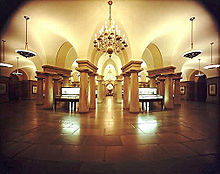United States Capitol crypt
The United States Capitol Crypt is the large circular room with forty neoclassical Doric columns just below the rotunda of the United States Capitol and was originally built as the base of the rotunda and the entrance to George Washington's burial chamber. It currently serves as a museum, a repository for six statues from the National Statuary Hall Collection, and a gift shop location.
Origin and construction
The crypt with the first designs that Dr. William Thornton had drawn for the United States Capitol , after which the rotunda was located between the two wings of the building. The space under the rotunda was needed to support the large room. Construction on the central section of the Capitol, which houses the rotunda and crypt, did not begin until after the British-American War in 1812.
Construction on the Capitol itself began in 1793 when the first US President George Washington laid the foundation stone for the north wing of the building. After Washington's death in 1799, Thornton asked the widow Martha Washington for permission to build a tomb for her husband in the Capitol. She agreed, and plans for the crypt below the level supporting the rotunda were made. This area was named the crypt, which served as the entrance to the burial chamber. Construction was disrupted several times, most notably by the British-American War, during which construction work came to a complete standstill in 1812. In August 1814, the British captured Washington and set the Capitol on fire, almost completely destroying the building. When construction work was resumed, what was destroyed by the fire was only restored.
The central section of the Capitol, with the rotunda and crypt, was not completed until 1827 under the supervision of the Capitol architect Charles Bulfinch. Plans to relocate Washington in the crypt have been abandoned due to legal problems with his will and the refusal of the then-owner of the Mount Vernon manor where Washington was buried in the family crypt. So the function of the room as a real crypt ended, but the name stayed anyway. In the center of the room, a marble compass has been set in the floor, marking the center of the District of Columbia , where all four quadrants of the city begin.
Todays use
The crypt serves as the main passage on the ground floor of the Capitol and as a museum. It is also the end point of all guided tours offered by the United States Capitol Guide Service . In the crypt there are several exhibits about the history of the construction work on the Capitol, from excavation and a model of the system to the completion of the Capitol Visitor Center . A gift shop is located on the east side and is operated by the United States Capitol Historical Society . An office for the Congressional Special Services Office is located on the northwest corner of the room.
The burial chamber below the crypt, originally reserved for George Washington's body, then served as a storage area for the Lincoln catafalk , the laying out table that was built for his body after the murder of Abraham Lincoln . Today the catafalk is in the Capitol Visitor Center.
National Statuary Hall Collection
Six statues from the National Statuary Hall Collection stand in the crypt. Clockwise from the east entrance these are:
- Robert R. Livingston from New York , bronze, Erastus Dow Palmer . 1875.
- Caesar Rodney from Delaware , marble, Bryant Baker, 1934.
- Samuel Adams from Massachusetts , marble, Anne Whitney, 1876.
- John C. Calhoun of South Carolina , marble, Frederick Ruckstull , 1910.
- Sakagawea from North Dakota , bronze, Leonard Crunelle, 2003.
- Crawford Williamson Long from Georgia , marble, J. Massey Rhind, 1926.
Web links
Individual evidence
- ^ Architect of the Capitol (AoC) site on Construction history.
- ↑ AoC site on construction history.
- ↑ AoC Construction History.
- ↑ AoC Construction history.
- ↑ a b AoC site on crypt.
Coordinates: 38 ° 53 '23.8 " N , 77 ° 0' 32.4" W.
